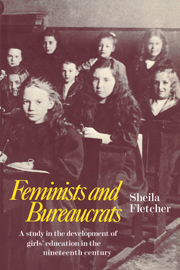Book contents
- Frontmatter
- Contents
- Preface
- Introduction: The Endowed Schools Act
- 1 The shaping of Section 12
- 2 The men who rejected the dead hand
- 3 The money problem
- 4 Opponents
- 5 Supporters
- 6 What was achieved
- 7 The changeover of 1874
- 8 The long haul
- 9 The Charity Commission spirit
- 10 The women's movement in the later years
- Appendices
- Notes
- Select Bibliography
- Index
1 - The shaping of Section 12
Published online by Cambridge University Press: 07 October 2011
- Frontmatter
- Contents
- Preface
- Introduction: The Endowed Schools Act
- 1 The shaping of Section 12
- 2 The men who rejected the dead hand
- 3 The money problem
- 4 Opponents
- 5 Supporters
- 6 What was achieved
- 7 The changeover of 1874
- 8 The long haul
- 9 The Charity Commission spirit
- 10 The women's movement in the later years
- Appendices
- Notes
- Select Bibliography
- Index
Summary
It is not easy to imagine that there can be any just cause why a woman of forty should be more ignorant than a boy of twelve years of age. If there be any good at all in female ignorance, this (to use a very colloquial phrase) is surely too much of a good thing.
Sydney Smith, 1810‘The education which women receive scarcely deserves the name’, wrote Mary Wollstonecraft towards the end of the eighteenth century. But as we know, little was done to improve it before at least the middle of the nineteenth, and those who sought to improve it then certainly did not claim affinity with the ‘hyena in petticoats’. The Owenite notions of the 1830s, according to which education was the lever to elevate Woman in the New Society, similarly ran into the sand. Those who at length took practical steps to provide middle-class girls with something better than drill in accomplishments when they left the nursery usually had practical ends in view. In 1848 when Frederick Maurice launched Queen's College, Harley Street, he took some pains to dissociate it from the ‘splendid but transitory foundation’ established by the heroine of Tennyson's The Princess. No highflown arguments about the rights of women assailed his audience who learned instead about the misery of destitute governesses. In this cruelly congested profession where, as the English Woman's Journal expressed it, ‘middle and upper classes meet, the one struggling up, the other drifting down’, genteel women strove to support themselves without any adequate education.
- Type
- Chapter
- Information
- Feminists and BureaucratsA Study in the Development of Girls' Education in the Nineteenth Century, pp. 12 - 29Publisher: Cambridge University PressPrint publication year: 1980



